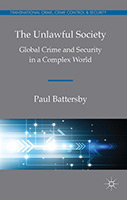The Unlawful Society: Global Crime and Security in a Complex World

Author: Paul Battersby
Publisher: Houndsmills, Basingstoke, Hampshire; New York: Palgrave Macmillan, 2014. 290p.
Reviewer: David O. Friedrichs | January 2015
During the course of the history of the developed world crime has for the most part been regarded as a local phenomenon, and to this day conventional crime in a local context remains the principal focus of most criminal justice agencies and of most criminologists. During the course of the twentieth century, in the case of the United States, crime as a state-wide phenomenon and then a national phenomenon was a growing focus of criminal justice agencies as well as of at least some criminologists. The growth of state police agencies and of federal police agencies – exemplified by the dramatic rise of the FBI from the 1930s on – is a reflection of this expanded focus. By the end of the twentieth century, and into the early stages of the twenty-first century, “globalization” became an increasingly ubiquitous focus of attention on many different levels. It seems quite certain that crime and its control, during the course of the twenty-first century, will increasingly take on a global, transnational character, and will have to be understood and addressed on a global level. While locally-based street crime will surely continue to be an important focus of concern for ordinary citizens, and at least some forms of street crime could experience upward spikes, there is also some reason to believe that street crime will be increasingly contained, in part by the pervasive growth of surveillance, broadly defined. Obviously the migration of a significant amount of crime from “the streets” to cyberspace is one of the defining dimensions of the contemporary environment of crime. But both in cyberspace and in natural space crime in many forms is increasingly crossing borders, and new forms of crime are emerging in a global context.
Early in the twentieth century, especially in the 1920s, the “Chicago school” pioneered an influential approach to the study of crime as a neighborhood phenomenon, with ethnographic methods as one piece of this. Early in the twenty-first century, criminology is a highly diverse enterprise in many respects, but the “general theory” of Gottfredson and Hirschi, addressing crime as a consequence of low self-control and poor parenting, is arguably the most widely invoked and tested criminological theory, at least in the United States. Whether the focus is on neighborhood crime or the low self-control form of explanation, the basic premise here is that crime is not an especially complex phenomenon, and it can be quite efficiently studied and understood. The book under review takes a very different tack, one potently at odds with the mainstream criminological focus, in its approach to the phenomenon of crime.
Paul Battersby, the author of The Unlawful Society, is an associate professor and head of Global Studies at the Royal Melbourne Institute of Technology University in Australia. He has co-authored an earlier book on crime in a global context and has co-edited a Handbook of Globalization. Accordingly, he comes at the topic of this book – captured by its subtitle, “Global Crime and Security in a Complex World” – from a primary concern with the impact of globalization, as opposed to a conventional criminological framework. First, he is here concerned principally with those forms of crime which occur in a transnational or global context. Second, he links his analysis of such crime throughout to the increasingly pronounced global concern with “security,” broadly defined. And third, he invokes the notion of “complexity” quite consistently during the course of his analysis of global crime and security. In my own view, one of the reasons for the great popularity of Gottfredson and Hirschi’s general theory is precisely its claim that crime and criminality are simple, not complex phenomena. Accordingly, their theory lends itself to quite straightforward analysis and measurement. In both psychological and practical terms it is more attractive to believe that the world is simple, not complex, and even on a global level that the world is “flat,” not multi-leveled. I believe Battersby gets much closer to the unfortunate truth that the world of emerging crime and security issues in a global context is in fact endlessly complex. This approach is likely to deter any number of potential readers, but in my view a sophisticated criminology that aspires to remain relevant in a rapidly changing world must contend with its endless complexity.
Altogether, this book is an impressive achievement. The author’s claim that it is the culmination of more than fifteen years of engagement with the topics addressed is wholly credible. He acknowledges that the form of analysis set forth in his book will be resisted by some both due to its innovative character and its criticisms of established forms of analysis of crime. The six chapters of this book address, broadly speaking, the following topics: the measurement of the costs of transnational crime; the increasing convergence of complex forms of crime with complex forms of security; the globalization of state crime; crimes of corporations in relation to systemic risk; the complicated policy choices arising out of international humanitarianism; and the relevance of a “cosmopolitan code” in an amoral, complex globalized world. Transnational organized crime is arguably the most fully studied form of global crime. The author here evaluates the claims made about the true nature of the threat of such crime. Since 9/11 in particular, international terrorism has, of course, received an immense amount of attention. For Battersby, the alleged crime-terror threat must be understood in terms of security risk management objectives of Global North states. His attention to state criminality specifically examines the strategies and justifications adopted by state leaders to disregard or evade the requirements of international law, as a means of addressing perceived threats to the security of the state. In a parallel vein, corporations that operate transnationally disregard or evade regulations and laws intended to prevent harmful outcomes from their activities. The intensely competitive character of the global marketplace contributes to the adoption of corporate policies and practices that are at odds with legal requirements, but are seen as necessary for surviving and profiting in this marketplace. In an arguably especially contentious chapter, Battersby explores the unlawfulness associated with professed humanitarian initiatives undertaken by private sector parties. This reviewer is especially receptive to the argument that much harm has been done in the name of Global North “development projects” (e.g., dams) in the Global South. In his concluding chapter, Battersby addresses some of the broader moral implications of the current global quest to control crime and expand security. The intentional transgression of criminal law (unlawfulness) and both its promotion and tolerance by public and private sector entities, is one core focus of Battersby’s analysis. More specifically, unlawfulness “serves as an intermediate category between legality and criminality where the rightness of an action is conceived according to the extent to which it advances (affirms) or retards (denies) universally agreed principles” (p. 7). Battersby differentiates between, and diagrams, the relationship between the lawful and unlawful on the one hand, and the legal and illegal on the other.
One aspect of the complexity of the world that Battersby addresses in this book is signaled at the outset by a list of well over one hundred abbreviations, from ABC (Australian Broadcasting Corporation) to WVA (World Vision Australia), which are invoked at some point. The author has engaged with and brings in appropriate references to an impressive range of key modern thinkers, including Arendt, Niebuhr, and Rawls. He also applies such influential social science concepts as asymmetrical conflict, informationalization, the networked state and risk management. Such concepts as these are then applied to understanding a range of crimes occurring in the global context, such as cybercrime, transnational drug trafficking, the crimes of major corporations (e.g., environmental crimes) and state criminality (e.g., genocide). Some of the relatively recent events that are considered in relation to global crime and security concerns include the Arab Spring, the Asian financial crisis, the Deepwater Horizon oil spill, and the wars in Iraq and Afghanistan.
One of the blurbs on the back of this book suggests that it is “accessible,” but it should be noted – perhaps obviously by this point – that it is not an easy read. Many formulations such as the following can be found throughout the book: “Convergence thinking is, arguably, a manifestation of the modernist drive to create order in the midst of complexity that constructs ‘individuated’ crime and terror subjects but ignores the overarching forces that disrupt and destabilize the global system” (p. 15); “[t]he analysis of crime and security needs must travel through a disquieting meta-logical universe to reach the cosmic heights of conceit from which to glimpse negative impressions of contemporary global society”(p. 16); and, “[g]lobal consciousness or awareness – globality – emerges, according to neo-Marxist interpretations, through the production of global consumer products which create the psychological space for transnational social consciousness to emerge as the locus of ‘counter power’ to global capitalism and the capitalist state” (p. 169). It is left up to the individual reader to determine in which instances such formulations are merited and contribute to a richer understanding of complex issues or are excessively pretentious, ambiguous and not helpful. I strongly suspect that the great majority of criminologists will resist taking on this book, both because they will regard its framework and focus as not useful in relation to their own professional preoccupations, and because of the intrinsically demanding nature of the analysis advanced here. Some criminologists may choose to quite selectively “mine” the book for some specific insights or observations relevant to their work: e.g., on transnational drug trafficking. Criminologists – and more broadly, any serious students of crime and criminal law – who commit themselves to engaging fully with the book should be rewarded with a richer, more sophisticated understanding of the increasingly complex world within which crime and its control plays out.
David O. Friedrichs, Distinguished Professor of Sociology, Criminal Justice & Criminology, University of Scranton


